Key takeaways:
- Selective mutism is often misunderstood; raising awareness can foster empathy and support for affected children and their families.
- Multidisciplinary approaches are essential for effective intervention, bringing together diverse expertise to address the unique needs of each child.
- Collaboration among professionals enhances communication strategies, leading to more effective interventions and emotional support for children.
- Training and education for caregivers and educators can improve understanding and support for children with selective mutism, facilitating their communication development.
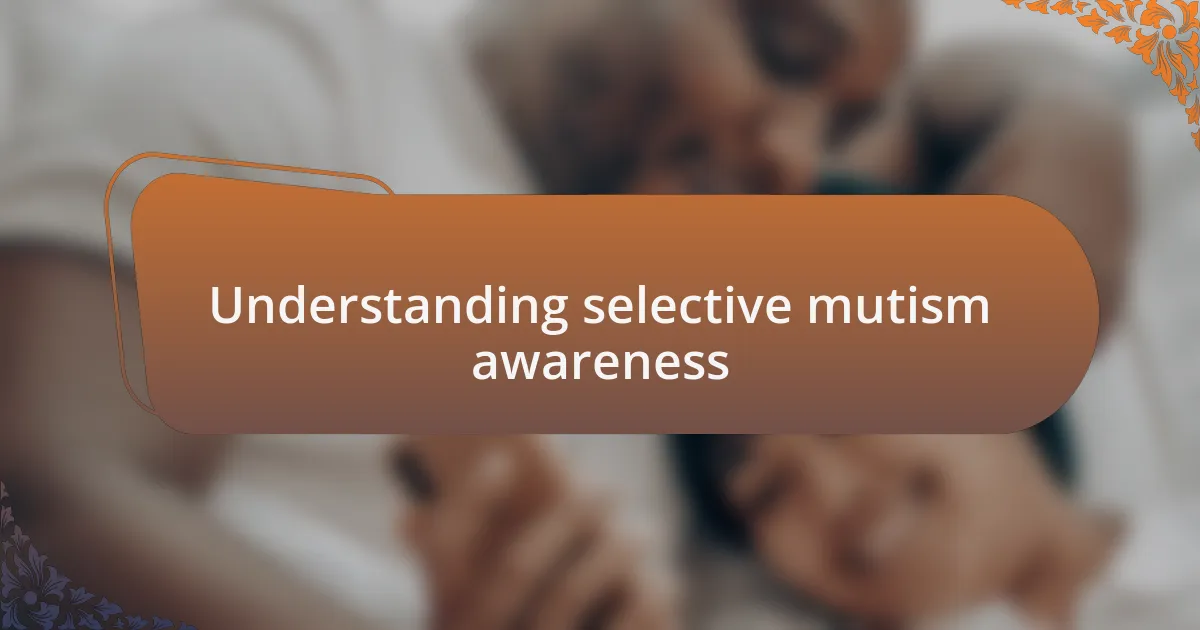
Understanding selective mutism awareness
Selective mutism can often be a misunderstood condition, leading to feelings of isolation for both the child and their family. I remember a moment when I first saw a child with selective mutism at school; their silence, coupled with the struggle in others to understand, highlighted just how crucial awareness is. Have you ever considered how challenging it must be for a child to want to communicate but feel completely unable to do so in certain settings?
Awareness plays a pivotal role in fostering an environment of empathy and support. It’s not just about recognizing the condition, but also understanding the underlying anxiety that manifests as silence. I vividly recall a parent expressing their frustration over their child’s inability to speak at school, yet the relief on their face when they finally understood that it wasn’t defiance, but rather a deep-seated fear, was incredible.
When we embrace and spread awareness of selective mutism, we not only help individuals understand the nuances of the condition but also advocate for tailored strategies that can facilitate communication. By sharing stories and insights, I believe we can dispel myths and create a more compassionate landscape for those affected. How transformative do you think it would be if we all took the time to learn about and advocate for these children?
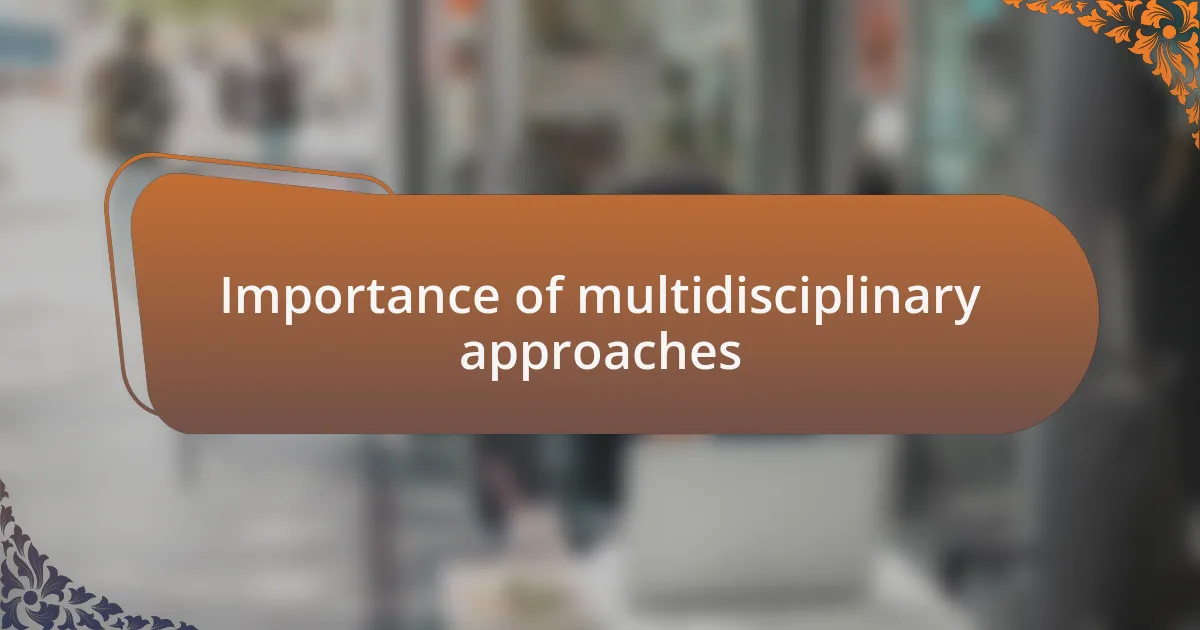
Importance of multidisciplinary approaches
Multidisciplinary approaches are vital for effectively addressing selective mutism, as they bring together varied perspectives and expertise. In my experience, working alongside speech therapists, psychologists, and educators creates a holistic support network for the child. Have you ever thought about how different professionals might identify and tackle unique aspects of a child’s experience?
Each professional involved contributes distinct tools and strategies tailored to the child’s needs. For instance, when I collaborated with a child psychologist, we discovered that the root of the child’s silence was linked to a specific trauma. This breakthrough wouldn’t have been possible without a team effort, demonstrating how pivotal different insights can be.
Furthermore, multidisciplinary approaches promote a cohesive plan that is both comprehensive and adaptive. I recall how a coordinated effort among teachers, counselors, and parents helped one particular child thrive in school after initially facing significant challenges. Emphasizing open communication among all parties can foster an understanding that allows the child to flourish—don’t you think that this synergy could be the key unlock potential in children with selective mutism?
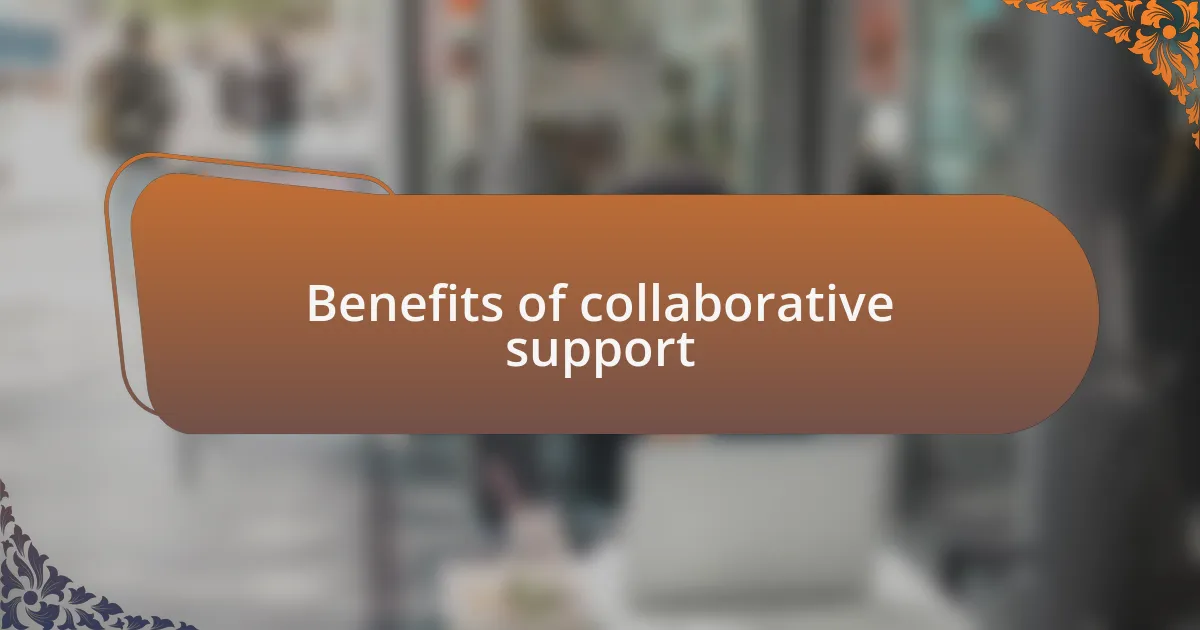
Benefits of collaborative support
Collaborative support offers a unique advantage; it enables different professionals to share insights that enhance interventions. For example, during a project I worked on, a speech therapist introduced engaging games that encouraged a child to express themselves verbally in a playful environment. This approach wouldn’t have been as effective without input from the child’s teacher, who tailored classroom activities to further build that confidence. Have you seen how collaboration can transform simple techniques into powerful tools?
Another benefit lies in the continuous feedback loop that emerges from multidisciplinary teams. In one case, I witnessed a parent and a psychologist regularly updating each other about a child’s progress, allowing for real-time adjustments. I remember feeling impressed by how this constant exchange of information created a supportive atmosphere and kept everyone focused on the child’s evolving needs. Isn’t it amazing how flexible support can lead to breakthroughs that help children realize their voices?
Additionally, emotional support flourishes when collaborative efforts thrive. I recall a moment when a child, who had initially been uncommunicative, began sharing thoughts with this team. Witnessing that joy in progress reinforced for me how critical these connections are; each member’s encouragement contributed to a sense of security and validation for the child. Don’t you think that this emotional backing is as vital as any therapeutic technique?
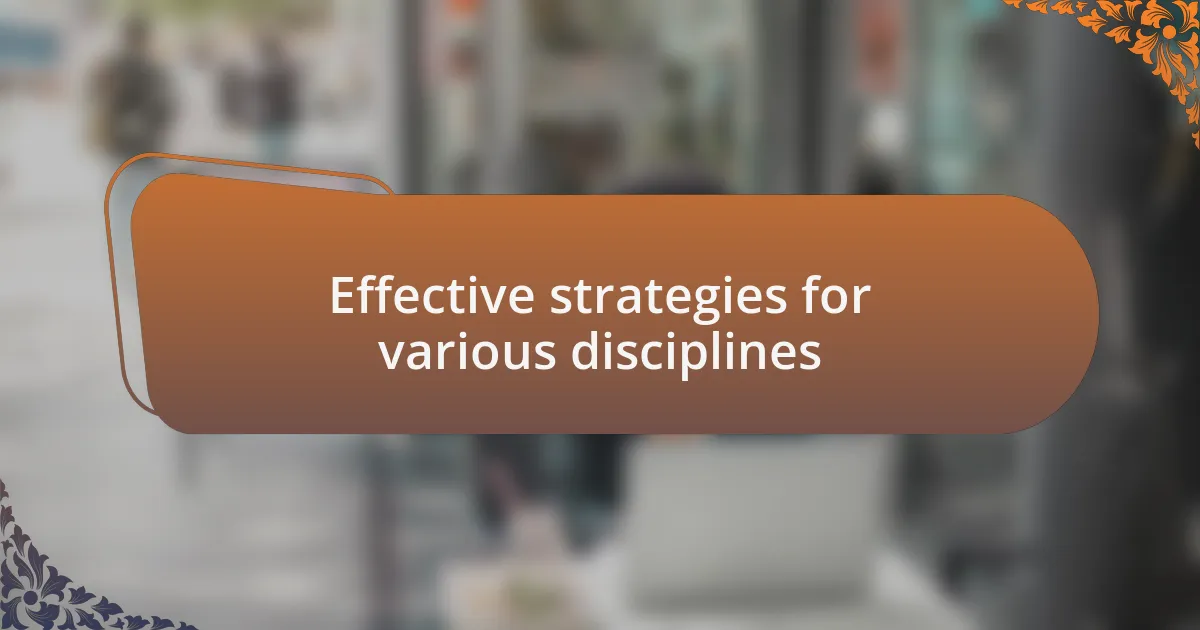
Effective strategies for various disciplines
One effective strategy involves creating a consistent communication plan among team members. I recall a project where a special educator, a speech therapist, and a child psychologist met weekly to discuss strategies tailored to a specific child. This regular interaction not only ensured everyone was on the same page but also created a cohesive approach that aligned their techniques. How often do we underestimate the power of shared dialogue?
Another approach is integrating activities that combine therapeutic techniques from multiple disciplines. I once observed an art therapist and a speech therapist collaborate on a session where children expressed their feelings through drawings, which were then used as conversation starters. It was extraordinary to see how creativity nudged children out of their shells and sparked meaningful dialogue. Isn’t it fascinating how combining disciplines can unlock new avenues for expression?
Finally, training caregivers in multidisciplinary strategies can fortify support at home. I remember conducting a workshop where parents learned simple techniques from speech therapy and social skills training. The impact was immediate; parents felt more equipped to reinforce what their child learned in therapy. Can you see how empowering caregivers transforms the entire support network around a child?
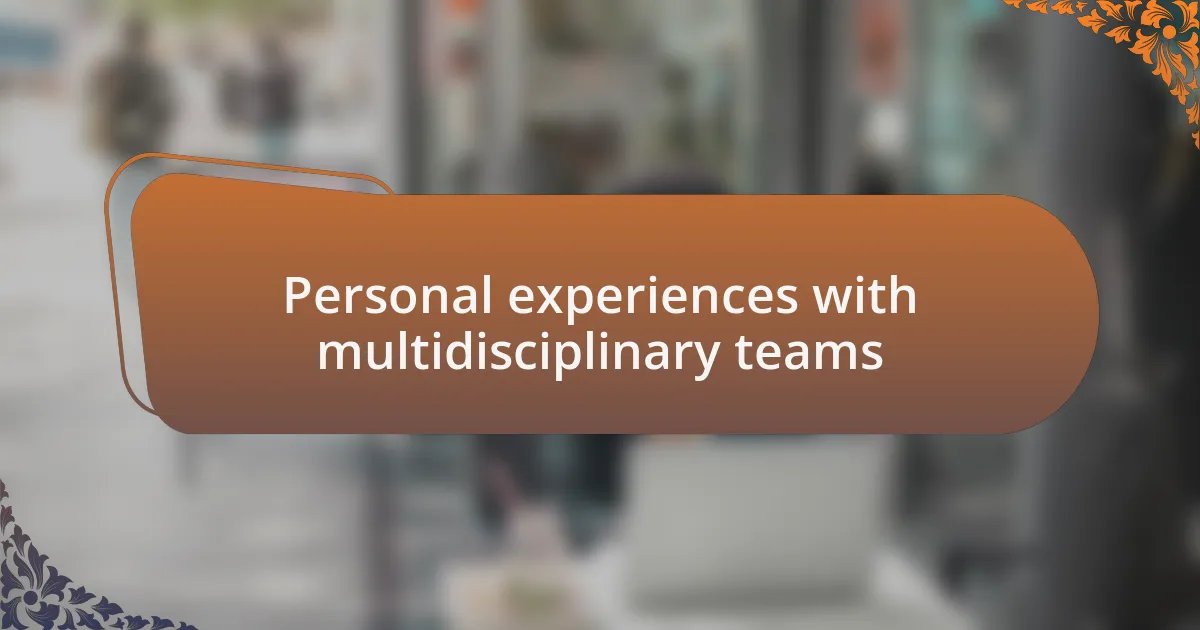
Personal experiences with multidisciplinary teams
Collaborating with multidisciplinary teams has shaped my perspective on how effective support can be. I remember a particular instance when a speech therapist facilitated a joint meeting with myself and the occupational therapist. As we shared insights, I felt a palpable sense of synergy developing. How often do we realize that a simple exchange of ideas can lead to powerful strategies? It was through this collaboration that we crafted an approach addressing both communication and sensory needs for a child, showcasing how teamwork can enhance individualized support.
There was another time when I participated in a case conference that included a neurologist, a behavior analyst, and a family therapist. Each professional brought a unique lens to the child’s situation, which allowed us to formulate a holistic understanding of the challenges at hand. The discussions were robust and at times, emotionally charged. I felt a deep connection to the child’s story as we fleshed out a comprehensive plan together. Isn’t it amazing how when varied expertise comes together, the focus shifts from just symptoms to the whole child?
During my experience with a multidisciplinary approach, I was captivated by the different perspectives that came together for one child’s benefit. A school psychologist and I once devised a plan that included classroom adjustments along with therapeutic sessions. Watching the child gradually become more comfortable speaking up in class was incredibly rewarding. It leads me to wonder, how many children suffer silently without this integrated support? In these instances, the combined efforts created a ripple effect, demonstrating how deeply interconnected our fields truly are.

Reflections on successful outcomes
Successful outcomes often emerge from the most unexpected collaborations. I recall attending a session with a behavioral therapist who introduced the idea of integrating play therapy into our approach. Witnessing a shy child begin to express themselves through play was truly eye-opening. It made me reflect: how often do we overlook the power of play in communication?
In another instance, I worked alongside a physician who emphasized the importance of medical assessment in understanding a child’s selectivity in speaking. Their perspective helped us identify underlying anxiety triggers that we hadn’t considered before. It was a humbling moment to see how a medical viewpoint complemented our educational strategies, reinforcing the idea that success is multifaceted.
I’ve observed that the stories of resilience within our multidisciplinary framework are deeply inspiring. One child’s journey from non-communication to sharing thoughts openly in a group setting left me in awe. Isn’t it fascinating how different approaches can unlock potential, transforming silence into vibrant expression? Each success story serves as a reminder that when we combine our expertise, the outcomes aren’t just favorable; they are life-changing.
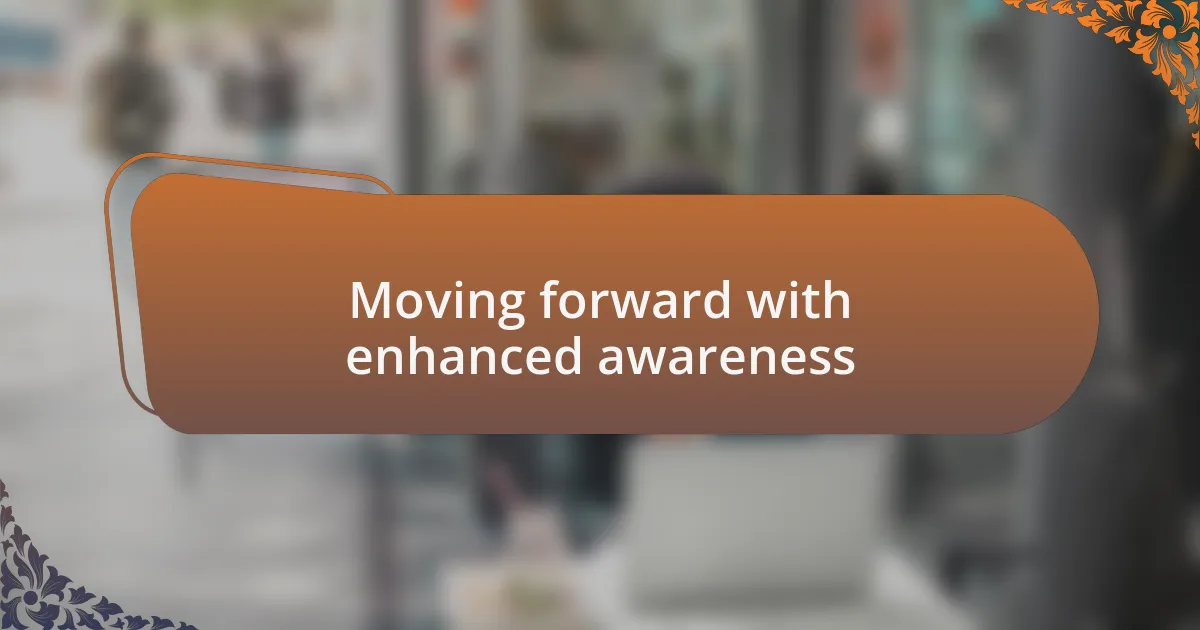
Moving forward with enhanced awareness
Moving forward with enhanced awareness requires a collective commitment to understanding the complexities of selective mutism. I remember a workshop where a parent shared their experience of navigating the school system for their child. Listening to their passion made me realize how vital it is for educators to not only recognize the signs of selective mutism but also to empathize with the challenges families face. How can we expect progress if we don’t foster a deeper understanding among all stakeholders?
As I delved deeper into the connections between multidisciplinary approaches, I was struck by how much knowledge can be pooled from diverse fields. During a discussion with a speech-language pathologist, I was reminded that communication goes beyond verbal skills—it encompasses non-verbal cues and emotional expression. It’s intriguing to consider how a child may communicate a wealth of feelings through gestures or art. Have we truly tapped into all the ways a child can express themselves?
Additionally, enhancing awareness means taking proactive steps toward training and education. I recently facilitated a session aimed at teachers, where I encouraged them to share their experiences with students who have communication difficulties. The insights gathered highlighted a significant gap in training. It made me wonder: if we invest more in educating those on the front lines, could we shift the narrative from silence to conversation?